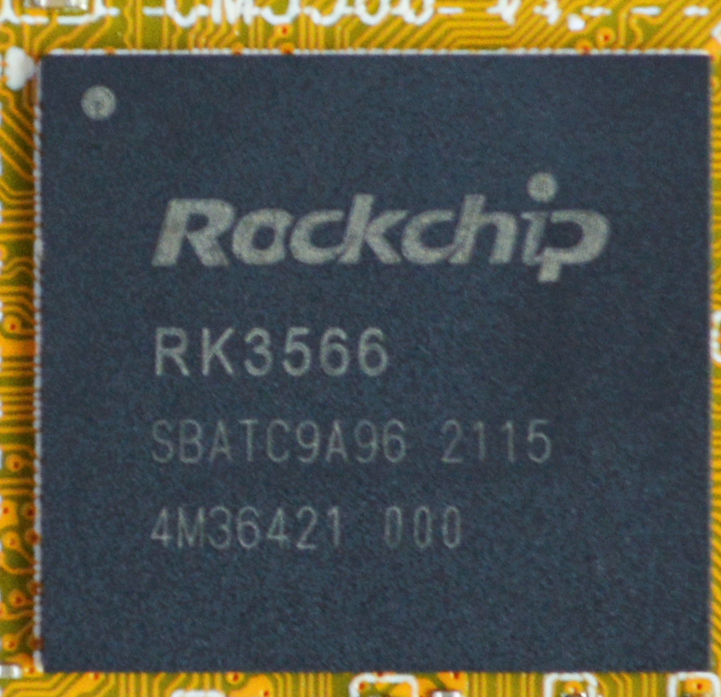|
Cortex A8
The ARM Cortex-A8 is a 32-bit processor core licensed by ARM Holdings implementing the ARMv7-A architecture. Compared to the ARM11, the Cortex-A8 is a dual-issue superscalar design, achieving roughly twice the instructions per cycle. The Cortex-A8 was the first Cortex design to be adopted on a large scale in consumer devices. Features Key features of the Cortex-A8 core are: * Frequency from 600 MHz to 1 GHz and above * Superscalar dual-issue microarchitecture * NEON SIMD instruction set extension * 13-stage integer pipeline and 10-stage NEON pipeline * VFPv3 floating-point unit * Thumb-2 instruction set encoding * Jazelle RCT (also known as ThumbEE instruction set) * Advanced branch prediction unit with >95% accuracy * Integrated level 2 Cache (0–4 MiB) * 2.0 DMIPS/MHz Chips Several system-on-chips (SoC) have implemented the Cortex-A8 core, including: * Allwinner A1X * Apple A4 * Freescale Semiconductor i.MX51 * Rockchip RK2918, RK2906 * Samsung Exynos 31 ... [...More Info...] [...Related Items...] OR: [Wikipedia] [Google] [Baidu] |
Gigahertz
The hertz (symbol: Hz) is the unit of frequency in the International System of Units (SI), often described as being equivalent to one event (or cycle) per second. The hertz is an SI derived unit whose formal expression in terms of SI base units is 1/s or s−1, meaning that one hertz is one per second or the reciprocal of one second. It is used only in the case of periodic events. It is named after Heinrich Rudolf Hertz (1857–1894), the first person to provide conclusive proof of the existence of electromagnetic waves. For high frequencies, the unit is commonly expressed in multiples: kilohertz (kHz), megahertz (MHz), gigahertz (GHz), terahertz (THz). Some of the unit's most common uses are in the description of periodic waveforms and musical tones, particularly those used in radio- and audio-related applications. It is also used to describe the clock speeds at which computers and other electronics are driven. The units are sometimes also used as a representation of th ... [...More Info...] [...Related Items...] OR: [Wikipedia] [Google] [Baidu] |
Dhrystone
Dhrystone is a synthetic computing benchmark program developed in 1984 by Reinhold P. Weicker intended to be representative of system (integer) programming. The Dhrystone grew to become representative of general processor ( CPU) performance. The name "Dhrystone" is a pun on a different benchmark algorithm called Whetstone, which emphasizes floating point performance. With Dhrystone, Weicker gathered meta-data from a broad range of software, including programs written in FORTRAN, PL/1, SAL, ALGOL 68, and Pascal. He then characterized these programs in terms of various common constructs: procedure calls, pointer indirections, assignments, etc. From this he wrote the Dhrystone benchmark to correspond to a representative mix. Dhrystone was published in Ada, with the C version for Unix developed by Rick Richardson ("version 1.1") greatly contributing to its popularity. Dhrystone vs. Whetstone The Dhrystone benchmark contains no floating point operations, thus the name is a p ... [...More Info...] [...Related Items...] OR: [Wikipedia] [Google] [Baidu] |
List Of ARM Cores
A list is a set of discrete items of information collected and set forth in some format for utility, entertainment, or other purposes. A list may be memorialized in any number of ways, including existing only in the mind of the list-maker, but lists are frequently written down on paper, or maintained electronically. Lists are "most frequently a tool", and "one does not ''read'' but only ''uses'' a list: one looks up the relevant information in it, but usually does not need to deal with it as a whole". Lucie Doležalová,The Potential and Limitations of Studying Lists, in Lucie Doležalová, ed., ''The Charm of a List: From the Sumerians to Computerised Data Processing'' (2009). Purpose It has been observed that, with a few exceptions, "the scholarship on lists remains fragmented". David Wallechinsky, a co-author of '' The Book of Lists'', described the attraction of lists as being "because we live in an era of overstimulation, especially in terms of information, and lists help ... [...More Info...] [...Related Items...] OR: [Wikipedia] [Google] [Baidu] |
List Of Applications Of ARM Cores
This is a list of products using processors (i.e. central processing units) based on the ARM architecture family, sorted by generation release and name. __TOC__ List of products See also * ARM architecture family ARM (stylised in lowercase as arm, formerly an acronym for Advanced RISC Machines and originally Acorn RISC Machine) is a family of RISC instruction set architectures (ISAs) for computer processors. Arm Holdings develops the ISAs and lic ... * Semiconductor intellectual property core (IP cores) * List of ARM processors * Field-programmable gate array cores – processors for FPGA Notes References {{- ... [...More Info...] [...Related Items...] OR: [Wikipedia] [Google] [Baidu] |
JTAG
JTAG (named after the Joint Test Action Group which codified it) is an industry standard for verifying designs of and testing printed circuit boards after manufacture. JTAG implements standards for on-chip instrumentation in electronic design automation (EDA) as a complementary tool to digital simulation. It specifies the use of a dedicated debug port implementing a serial communications interface for low-overhead access without requiring direct external access to the system address and data buses. The interface connects to an on-chip Test Access Port (TAP) that implements a stateful protocol to access a set of test registers that present chip logic levels and device capabilities of various parts. The Joint Test Action Group formed in 1985 to develop a method of verifying designs and testing printed circuit boards after manufacture. In 1990 the Institute of Electrical and Electronics Engineers codified the results of the effort in IEEE Standard 1149.1-1990, entitled ''Stand ... [...More Info...] [...Related Items...] OR: [Wikipedia] [Google] [Baidu] |
Comparison Of ARMv7-A Cores
This is a comparison of ARM instruction set architecture application processor cores designed by Arm Holdings ( ARM Cortex-A) and 3rd parties. It does not include ARM Cortex-R, ARM Cortex-M, or legacy ARM cores. ARMv7-A This is a table comparing 32-bit central processing units that implement the ARMv7-A (A means Application) instruction set architecture and mandatory or optional extensions of it, the last AArch32. ARMv8-A This is a table of 64/32-bit central processing units that implement the ARMv8-A instruction set architecture and mandatory or optional extensions of it. Most chips support the 32-bit ARMv7-A for legacy applications. All chips of this type have a floating-point unit (FPU) that is better than the one in older ARMv7-A and NEON (SIMD) chips. Some of these chips have coprocessors also include cores from the older 32-bit architecture (ARMv7). Some of the chips are SoCs and can combine both ARM Cortex-A53 and ARM Cortex-A57, such as the Samsung Exy ... [...More Info...] [...Related Items...] OR: [Wikipedia] [Google] [Baidu] |
Conexant
Conexant Systems, Inc. was an American-based software developer and fabless semiconductor company that developed technology for voice and audio processing, imaging and modems. The company began as a division of Rockwell International, before being spun off as a public company. Conexant itself then spun off several business units, creating independent public companies which included Skyworks Solutions and Mindspeed Technologies. The company was acquired by computing interface technology company Synaptics, Inc. in July 2017. History In 1996, Rockwell International Corporation incorporated its semiconductor division as Rockwell Semiconductor Systems, Inc. On January 4, 1999, Rockwell spun off Conexant Systems, Inc. as a public company. It was listed on the NASDAQ under symbol CNXT on January 4, 1999. At that time, Conexant became the world's largest, standalone communications- IC company. Dwight W. Decker was its first chief executive officer and chairman of its board of ... [...More Info...] [...Related Items...] OR: [Wikipedia] [Google] [Baidu] |
Texas Instruments OMAP
OMAP (Open Multimedia Applications Platform) is a family of image processor, image/video processors that was developed by Texas Instruments. They are proprietary system on chips (SoCs) for portable and mobile multimedia application software, applications. OMAP devices generally include a general-purpose ARM architecture processor core plus one or more specialized co-processors. Earlier OMAP variants commonly featured a variant of the Texas Instruments TMS320 series digital signal processor. The platform was created after December 12, 2002, as STMicroelectronics and Texas Instruments jointly announced an initiative for ''Open Mobile Application Processor Interfaces'' (OMAPI) intended to be used with 2G#2.5G (GPRS), 2.5 and 3G mobile phones, that were going to be produced during 2003. (This was later merged into a larger initiative and renamed the MIPI Alliance.) The OMAP was Texas Instruments' implementation of this standard. (The STMicroelectronics implementation was named Nomad ... [...More Info...] [...Related Items...] OR: [Wikipedia] [Google] [Baidu] |
Samsung Exynos
The Samsung Exynos (stylized as SΛMSUNG Exynos), formerly Hummingbird (), is a series of Arm-based system-on-chips developed by Samsung Electronics' System LSI division and manufactured by Samsung Foundry. It is a continuation of Samsung's earlier S3C, S5L and S5P line of SoCs. The first debut of Samsung's indigenously developed SoC is Samsung Hummingbird (S5PC110/111), later renamed as Exynos 3 Single 3110. Samsung announce it on July 27, 2009. In 2011, Samsung announced Exynos 4 Dual 4210 that was later equipped on Samsung Galaxy S II. Since then, Samsung has used Exynos as a representative brand name of their SoC, based on Arm Cortex cores. In 2017, Samsung launched their proprietary Arm ISA-based customized core designs, codenamed "Exynos M". Exynos M series core made a debut with Exynos M1 nicknamed "Mongoose", which was used for Exynos 8 Octa 8890. The Exynos M-series have been implemented throughout the flagship lineup of Samsung Exynos 9 series, until Exynos 990. Fro ... [...More Info...] [...Related Items...] OR: [Wikipedia] [Google] [Baidu] |
Rockchip
Rockchip (Fuzhou Rockchip Electronics Co., Ltd.) is a Chinese fabless semiconductor company based in Fuzhou, Fujian province. It has offices in Shanghai, Beijing, Shenzhen, Hangzhou and Hong Kong. It designs system on a chip (SoC) products, using the ARM architecture licensed from ARM Holdings for the majority of its projects. Rockchip was one of the top 50 fabless IC suppliers in 2018. The company established cooperation with Google, Microsoft and Intel. On 27 May 2014, Intel announced an agreement with Rockchip to adopt the Intel architecture for entry-level tablets. Rockchip is a supplier of SoCs to Chinese white-box tablet manufacturers as well as supplying OEMs such as Asus, HP, Samsung and Toshiba. Rockchip has been providing SoC products for tablets & PCs, streaming media TV boxes, AI audio & vision, IoT hardware since founded in 2001. Products Featured Products The RK3588 is Rockchip's current flagship SoC. It has a feature-reduced versions, including RK3582 an ... [...More Info...] [...Related Items...] OR: [Wikipedia] [Google] [Baidu] |
Freescale Semiconductor
Freescale Semiconductor, Inc. was an American semiconductor manufacturer. It was created by the divestiture of the Semiconductor Products Sector of Motorola in 2004. Freescale focused their integrated circuit products on the automotive, embedded and communications markets. It was bought by a private investor group in 2006, and subsequently merged with NXP Semiconductors in 2015. History Divestiture from Motorola and first IPO As of 2003, Motorola Semiconductor Products Sector earned US$5.0 billion in semiconductor sales in 2002 (out of US$27 billion sales for all of Motorola). Motorola announced that their semiconductor division would be divested on October 6, 2003 and would have a temporary name ''SPS Spinco''. Freescale completed its Initial public offering (IPO) on July 16, 2004, at a price of US$13. In its announcement, it estimated the stock price to be US$17.50- 19.50 but following a cooling of the market towards tech stocks, it lowered its price to US$13. Existing sh ... [...More Info...] [...Related Items...] OR: [Wikipedia] [Google] [Baidu] |





